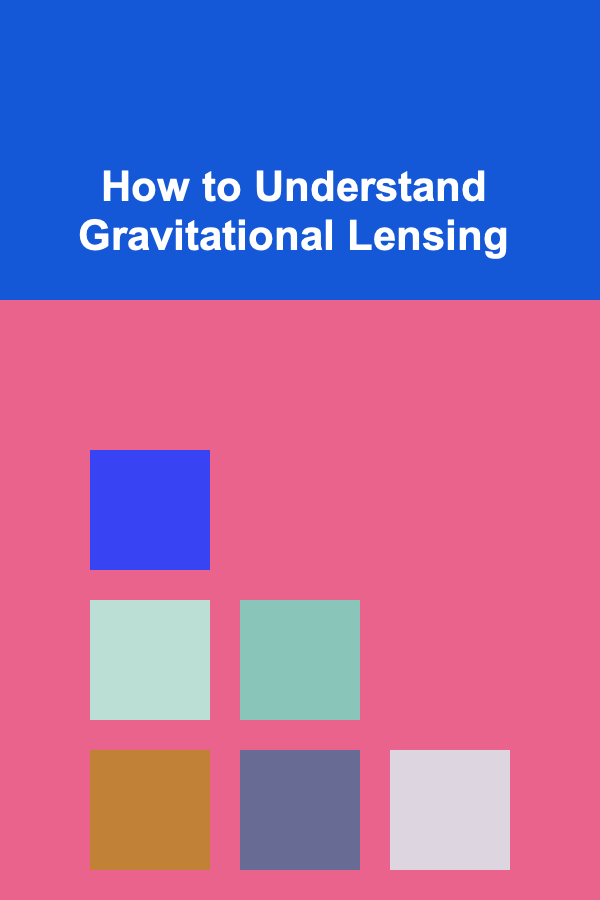
How to Understand Gravitational Lensing
ebook include PDF & Audio bundle (Micro Guide)
$12.99$11.99
Limited Time Offer! Order within the next:

Gravitational lensing is one of the most fascinating and mind-bending phenomena in astrophysics. It provides not only a deeper understanding of the nature of gravity, but also serves as a powerful tool for observing distant objects in the universe. In this article, we will explore the fundamental concepts behind gravitational lensing, how it occurs, its various types, and how it has shaped our understanding of the cosmos.
Introduction to Gravitational Lensing
Gravitational lensing is a phenomenon that occurs when the gravitational field of a massive object (such as a galaxy or black hole) bends the light coming from a distant object, like a star or another galaxy. This effect is predicted by Albert Einstein's General Theory of Relativity, which states that massive objects warp spacetime around them, causing the path of light to bend. Just as a glass lens bends light to focus an image, a gravitational field can bend light, hence the term "gravitational lensing."
The Basics of Gravitational Lensing
To understand gravitational lensing, it's important to grasp the basic principles of how light travels and how gravity interacts with it. Light, while moving at an immense speed of approximately 300,000 kilometers per second, follows the curvature of space-time. Gravity affects the trajectory of light in the same way it influences any object with mass. When light passes near a massive object, the space-time around that object is curved, and the light is deflected.
This bending of light results in several observable effects that can be used to gain information about the foreground object and the distant object whose light is being bent. The deflection of light can produce multiple images, distortions, or even magnification of the background object, much like how a lens magnifies the objects behind it.
The Role of Einstein's Theory of Relativity
Einstein's General Theory of Relativity is the cornerstone of gravitational lensing. According to this theory, gravity is not simply a force pulling objects together, but rather the result of mass causing a distortion in the fabric of space-time. Massive objects like stars or galaxies create "dips" or "warps" in space-time, and light traveling through this warped space follows a curved path.
Einstein's equations predict that the amount of light bending depends on the mass of the object causing the distortion and the distance between the observer, the lensing object, and the light source. The greater the mass of the object, the more pronounced the bending will be. This allows scientists to study the mass of distant objects that might otherwise be invisible, providing a unique opportunity to learn about the universe.
Types of Gravitational Lensing
Gravitational lensing can manifest in different ways, depending on the alignment of the light source, lensing object, and observer. There are three primary types of gravitational lensing: strong lensing, weak lensing, and microlensing. Each type provides different insights into the structure of the universe.
1. Strong Gravitational Lensing
Strong gravitational lensing occurs when the light source, lensing object, and observer are nearly perfectly aligned. In this case, the bending of light is so pronounced that it produces spectacular visual effects, such as multiple images of the background object or a complete ring of light known as an "Einstein ring." Strong lensing can also create arcs or other distorted shapes.
Einstein rings, for example, are rare but incredibly valuable to astronomers. They provide a unique way to study the mass of the lensing object, which could be a galaxy or even a black hole. By analyzing the size, shape, and brightness of the Einstein ring, scientists can infer the distribution of mass within the lensing object, even if it is too far away to observe directly.
2. Weak Gravitational Lensing
Weak gravitational lensing occurs when the alignment between the light source, lens, and observer is not perfect, resulting in a less noticeable effect. Instead of creating multiple images or arcs, weak lensing causes subtle distortions in the shape of background galaxies, known as "shearing." These distortions are so slight that they can only be detected statistically, over large samples of galaxies.
Weak lensing is particularly useful in studying the distribution of dark matter. Dark matter does not emit light or interact with electromagnetic radiation, making it invisible to direct observation. However, its gravitational influence on the light from background objects can be detected through weak lensing. By mapping the distortions in galaxy shapes, scientists can infer the distribution of dark matter in the universe.
3. Microlensing
Microlensing occurs when a smaller object, such as a star or a planet, passes in front of a more distant light source. Unlike strong lensing, microlensing does not produce multiple images or rings. Instead, it results in a brief, noticeable increase in the brightness of the background object, as the lensing object magnifies the light temporarily. The amount of magnification depends on the mass of the lensing object.
Microlensing is often used to detect exoplanets. When a planet orbits a star that is involved in a microlensing event, it can cause a characteristic change in the light curve, revealing its presence. Microlensing has been particularly useful in detecting objects that are too small or distant to be directly observed.
Gravitational Lensing as a Tool for Cosmic Discovery
Gravitational lensing is not just a curiosity of physics; it is an invaluable tool for astronomers. Through lensing, we can study the universe in ways that were previously impossible. Here are some of the most exciting applications of gravitational lensing in modern cosmology.
1. Mapping the Dark Matter
One of the most important applications of gravitational lensing is its ability to map the distribution of dark matter. Dark matter makes up approximately 27% of the universe's mass-energy content, yet it does not interact with electromagnetic radiation, making it invisible. However, its gravitational influence on light can be detected through weak lensing.
By observing how galaxies and clusters of galaxies bend the light from more distant objects, astronomers can create maps of dark matter in the universe. These maps help to understand the large-scale structure of the universe and provide insight into the role of dark matter in galaxy formation and evolution.
2. Studying Galaxy Clusters
Gravitational lensing can also be used to study the mass and structure of galaxy clusters. Galaxy clusters are the largest gravitationally bound structures in the universe, and they contain vast amounts of dark matter. By analyzing the lensing effects around galaxy clusters, scientists can measure the total mass of the cluster, including both the visible and invisible matter.
Lensing also allows scientists to study the distribution of mass within galaxy clusters, revealing the complex interplay between dark matter, gas, and galaxies. This is crucial for understanding how galaxy clusters form and evolve over cosmic time.
3. Investigating the Shape of the Universe
Gravitational lensing can be used to probe the geometry of the universe itself. By studying how light from distant galaxies is distorted by intervening objects, astronomers can test the predictions of General Relativity and refine our understanding of the large-scale structure of space-time. Lensing effects provide valuable information about the curvature of the universe, helping to determine whether the universe is flat, open, or closed.
4. Probing the Early Universe
Gravitational lensing allows scientists to study distant objects that would otherwise be too faint or far away to observe directly. This is particularly important when looking at the early universe, which is often obscured by intervening gas and dust. Gravitational lensing acts as a cosmic magnifying glass, bringing distant objects into view.
By studying the light from galaxies or quasars that have been lensed by intervening galaxy clusters, astronomers can gain insight into the properties of these distant objects and the conditions of the early universe. Lensing also helps to probe the nature of the first stars and galaxies that formed after the Big Bang.
Conclusion
Gravitational lensing is a powerful and fascinating tool that allows scientists to peer deeper into the universe than ever before. By bending light through the influence of massive objects, gravitational lensing reveals the distribution of dark matter, the structure of galaxy clusters, and the shape of the universe itself. It also provides a unique way to study distant objects and probe the early universe, offering clues to the fundamental workings of gravity and space-time.
As our understanding of gravitational lensing continues to evolve, it will undoubtedly remain a central tool in the study of cosmology, helping to unlock the mysteries of the universe and expand our knowledge of the cosmos. Whether it's exploring the nature of dark matter, studying the formation of galaxies, or investigating the curvature of space-time, gravitational lensing is reshaping our understanding of the universe in profound ways.
Reading More From Our Other Websites
- [Home Cleaning 101] How to Clean a Home After a Party: Quick and Effective Tips
- [Home Cleaning 101] How to Clean an Oven: Step-by-Step Guide for a Spotless Appliance
- [Personal Investment 101] How to Understand and Successfully Buy Government Bonds for Portfolio Stability
- [Home Pet Care 101] How to Keep Your Pet Calm During Home Renovations or Changes
- [Home Family Activity 101] How to Make Homemade Friendship Bracelets
- [Horseback Riding Tip 101] Best Trail Riding Routes for Advanced‑Intermediate Riders in the Rocky Mountain Region
- [Home Budget Decorating 101] How to Add Style to Your Home with Thrift Store Finds
- [Home Holiday Decoration 101] How to Choose the Perfect Christmas Tree Topper for Your Home Decor Style
- [Scrapbooking Tip 101] Creative Themes to Transform Your Scrapbook Album
- [Personal Care Tips 101] How to Reduce Puffiness with Eye Cream

How to Build a Checklist for Choosing Materials for Your Renovation
Read More
How to Create a Zen Space in Your Home
Read More
How to Establish a Decluttering Routine You Can Stick To
Read More
How to Protect Your Home Against Pests with Regular Maintenance
Read More
How to Store and Organize Shoes with Limited Closet Space
Read More
How to Develop a Sustainable Approach to Weight Management
Read MoreOther Products

How to Build a Checklist for Choosing Materials for Your Renovation
Read More
How to Create a Zen Space in Your Home
Read More
How to Establish a Decluttering Routine You Can Stick To
Read More
How to Protect Your Home Against Pests with Regular Maintenance
Read More
How to Store and Organize Shoes with Limited Closet Space
Read More